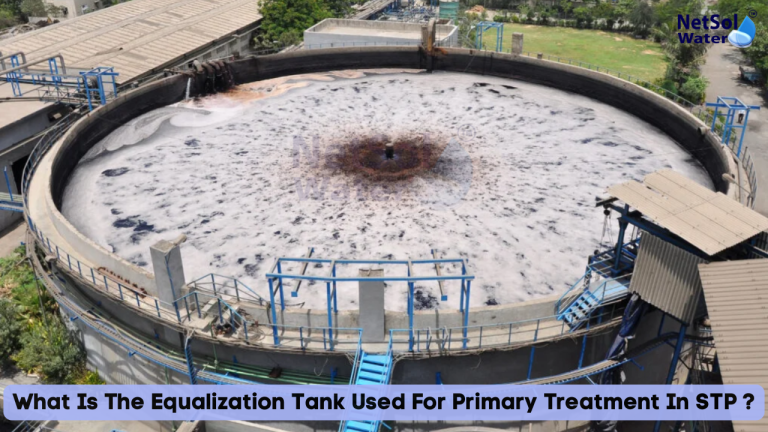
Daily fluctuation along with wet weather occurrences cause influent flows to fluctuate, which equalization tanks are employed to control. In order to keep solids suspended, stop deposition, plus balance the load on the treatment plant, mixing is required in these basins. The rectangular design of the tank allows for the positioning of air diffusers to cover the entire floor. Great, knowledgeable manufacturers like Commercial RO Plant are able to procure these components for the first primary treatment in STP plants. We will discuss what is the equalization tank used for primary treatment in STP in this blog in details.
Main Role or Job of the Equalization tank provided by Commercial RO Plant
The equalization tank works as a buffer, collecting raw incoming sewage at widely disparate rates before transferring it to the base of the STP plant with a constant flow rate.
Flow equalization is one technique for managing hydraulic velocity, or flow rate, in a wastewater treatment system such as an Sewage Treatment Plant. Flow equalization keeps high-volume incoming flow from pushing sediments, short-term surges in organic material, & numerous other hazardous contaminants beyond the treatment process. Furthermore, flow equalization facilitates all biological, chemical, & physical processes by controlling the flow through each stage of the treatment system.
By enabling storage to hold water when it enters too rapidly & delivering extra water once it arrives more gradually/slowly than planned as well as designed, flow equalization reduces variations/fluctuations in flow rate throughout a section of a system.
Equalizing the flow before supplying sewage or wastewater to the different treatment processes is a smart idea because the rate at which it enters the process may vary significantly throughout the day.
The oil, grease, plus grit trap & the bar screen compartment both supply sewage to the equalization tank. The equalization tank is the first primary storage tank in STP plants. Acting as a buffer, it collects incoming raw sewage at different fluctuating rates & transfers it to the other parts of the STP Plant at a steady (typical) flow rate. Sewage moves easily & swiftly at peak times. Sewage is discharged from the equalization tank during times of low demand when there is typically little to no entering sewage.
Design considerations for such a component under the Commercial RO Plant’s Special Supervision
The incoming sewer line is often gravity-fed as well as situated at a considerable depth below ground level. Because this will require very deep digging trenches & expensive construction, it is advised against creating STP tanks that are too deep which makes it a tough task to execute. The sewage in the tank needs to be forced by applying compressed air.
The following are the two main reasons that make it necessary:
1) It keeps the raw sewage aerated, preventing septicity or contamination & reducing the generation of odors.
2) It also keeps particles in suspension & keeps solids from settling in the tank, removing any requirement for manual tank cleaning.
As long as it permits the setup of air diffusers to provide complete floor coverage & uniform mixing across the whole floor surface, the tank can take on any shape. It should be possible to retrieve the diffusers: Diffusers (or multiple diffusers) can be removed & cleaned for regular maintenance. The Equalization tank will require less stoppage for manual cleaning as a result of this.
Equalization tank with regular maintenance, upkeep & operation by manufacturers such as Commercial RO Plant
1) Keep the air blending on at all times.
2) Verify that the mixing & air flow are constant across the tank’s floor.
3) Modify the diffuser’s location with the necessary airflow rate.
4) Maintain the equalization tank in STP Treatment to be empty just before the peak loading hours (to stop spilling).
5) Examine & empty out blocked diffusers regularly.
6) Manually remove any settled mulch or silt no fewer than once a year.
Why are Equalization Tanks used for Primary Treatment in STP?
1) To lower the Equalization tank’s temperature.
2) To ensure consistent mixing.
3) To give the most favorable measure of HCl Chemical for neutralization of substances.
4) To increase the growth of bacteria in the Fixed Bed Bio Reactor.
5) To cut down the extent of insoluble BOD & COD in the STP Primary treatment system.
6) To prevent the air circulation network from being covered with solids.
7) The equalization tank’s air volume is increased during the wastewater STP treatment process.
8) The Equalization tank’s odor must be eliminated because of the anaerobic process.
9) To increase the overall value of the ecosystem.
10) To reduce the amount of current plus electrodes utilised in an EC system.
Conclusion
Commercial RO Plant is a proudly a good manufacturer of Wastewater, Water treatment Plants & the Equalization tank related equipment’s. Staff at this company surroundings constantly work to give our clients the highest return on their investment at Commercial RO Plant. We offer the best professional answers to all of your questions since we recognize. That when it comes to installing STP coupled with Equalization tank system units, customer satisfaction is the most crucial factor. So when you talk about What Is The Equalization Tank Used For Primary Treatment In STP plant in above we mentioned all the factors that tells the use of equalization tank in STP.
Commercial RO Plant is a top manufacturer of water & wastewater treatment plants located in Greater Noida. Based on customer feedback & the caliber of our work, we are the most exacting organization in the sector. Commercial RO Plant is known for the best water treatment equipment providers like Equalization tanks for Primary Treatment in the STP Plants. As a finest commercial RO plant manufacturers, industrial RO plant manufacturer, Water-Softening Plant Manufacturers & ETP plant manufacturers.
